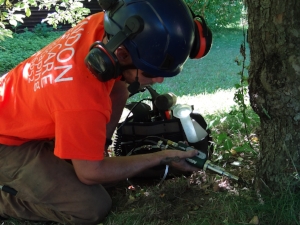Gypsy Moth Caterpillars in Amherst, Pelham, and Belchertown
Gypsy moths can be a big, hairy nuisance on your trees in the summer, eating leaves and raining down poop on your house, driveway, lawn, car — and your head if you pass beneath!

If you hear rain, and it’s not raining, that’s caterpillar poop.

Bite marks on a maple leaf in Granby, MA
In 2017 Massachusetts experienced a gypsy moth population boom, and this invasive pest defoliated 923,000 acres statewide, according to the DCR. This year, while not as severe, the problem persists. Locally, we’re seeing this in parts of Amherst, Pelham, Belchertown, Granby, and eastward.
Oaks are the preferred feast for gypsy moth caterpillars, but they will also feast on maple trees, birches, apples, willows, poplars, and hawthorns. Even healthy trees will be at risk after two or more years of defoliation, and susceptible to disease and other opportunistic pests that will attack the trees in their weakened states.
To avoid the cost of removing dying or dead trees, and the loss of their value on your property, there are several actions you can take against these pests.
How can you protect your trees from gypsy moth infestations?
First, know how to identify gypsy moths throughout their life cycle. The larvae emerge in early May, depending on the weather conditions, and start to eat the leaves. Toward the end of June, the caterpillars will pupate, and the adult moths emerge by mid-July. Buff-colored egg masses are laid in early August; you can see them not only on trees but on other surfaces outside (house, car, furniture, etc.).

Female gypsy moth producing an egg mass
Observation of gypsy moth populations on your property is important, and if significant populations are noted there are several options for treatment that we recommend.
- Scrape egg masses off in the winter months. This will help reduce populations, though it won’t eradicate them completely.
- B.t. insecticide spray: Bacillus thuringiensis (var. kurstaki) is a bacterial pathogen that is toxic only to larvae of moths and butterflies. We can do a foliar application of the bacteria in the spring when the caterpillars are still small. The larvae eat the leaves, ingest the bacteria, and die. But it is not 100% effective, since you must rely on the caterpillars to eat the leaves that were sprayed, and many trees are too tall to reach the tops. However, it is a completely non-toxic control option to reduce populations for a season.
- Lepitect infusible: If you’re looking for a stronger alternative, this chemical treatment is injected directly into the trunk of the tree and taken up into the tree’s vascular system. Results are very positive and longer lasting (about two years of control), and the injection method is environmentally friendly, posing no toxic threat to kids, pets, or wildlife.
Do you have gypsy moths on your property?
Schedule a quote with Lyndon Tree Care & Landscaping for safe, effective treatment of your trees. Give us a call at 413-835-6052!

Lyndon Tree Care injecting crabapple trunk in Amherst, MA to treat against gypsy moths
